-
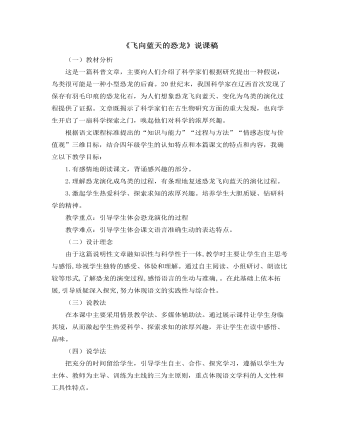
部编人教版四年级下册《 飞向蓝天的恐龙》说课稿
二、精读重点段,理解演化过程接下来我直奔重点-——课文的第3、4自然段。我以“让我们穿越时空隧道,一起去中生代的地球,看看恐龙的演化过程”这一陈述,十分自然地引出后面的学习。在学习中,我紧紧围绕“恐龙是如何飞向蓝天的”这一问题,设计了合作学习表格,教给学生抓关键词来填表格的方法,引导学生边读边思考,学会学习,学生在完成表格的过程中,不仅理清了课文的叙述顺序,也清楚地知道了恐龙飞向蓝天的过程。有了表格的提示,学生们把课文梳理得更清楚简洁。我又通过填空,图片解说,以及不同形式的朗读进一步加深印象。学生通过自主的,入情入境的朗读,读懂了课文。读的要求明确,读的时间充足,读的层次清楚,使学生亲历阅读过程,走进文本。
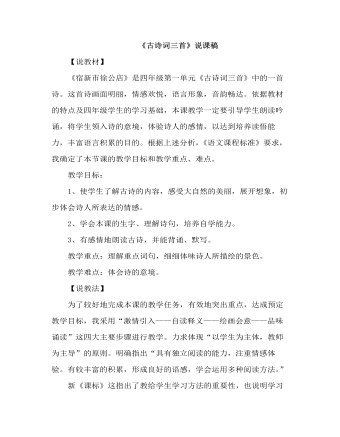
部编人教版四年级下册《古诗词三首》说课稿
教学目标:1、使学生了解古诗的内容,感受大自然的美丽,展开想象,初步体会诗人所表达的情感。2、学会本课的生字、理解诗句,培养自学能力。3、有感情地朗读古诗,并能背诵、默写。教学重点:理解重点词句,细细体味诗人所描绘的景色。教学难点:体会诗的意境。【说教法】为了较好地完成本课的教学任务,有效地突出重点,达成预定教学目标,我采用“激情引入——自读释义——绘画会意——品味诵读”这四大主要步骤进行教学。力求体现“以学生为主体,教师为主导”的原则。明确指出“具有独立阅读的能力,注重情感体验。有较丰富的积累,形成良好的语感,学会运用多种阅读方法。”新《课标》这指出了教给学生学习方法的重要性,也说明学习方法远远比学得的知识重要。因此,我要求学生在学习过程中,充分地读书,充分地交流,充分地参与,充分地合作。主要学习步骤为:自读、交流、质疑、绘画、品读。
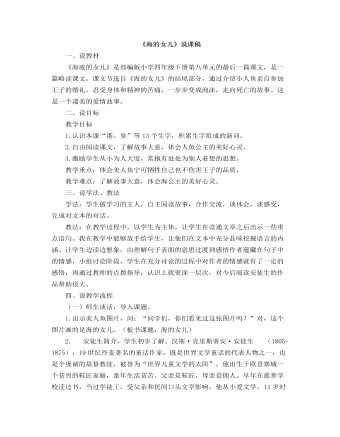
部编人教版四年级下册《海的女儿》说课稿
一、说教材《海底的女儿》是部编版小学四年级下册第八单元的最后一篇课文,是一篇略读课文。课文节选自《海的女儿》的结尾部分,通过介绍小人鱼亲自参加王子的婚礼,忍受身体和精神的苦痛,一步步变成泡沫,走向死亡的故事。这是一个凄美的爱情故事。 二、说目标教学目标1.认识本课“港、宴”等13个生字,积累生字组成的新词。2.自由阅读课文,了解故事大意,体会人鱼公主的美好心灵。3.激励学生从小为人大度,常抱有处处为别人着想的思想。教学重点:体会美人鱼宁可牺牲自己也不伤害王子的品质。教学难点:了解故事大意,体会海公主的美好心灵。

部编人教版四年级下册《记金华的双龙洞》说课稿(一)
一、教材分析《记金华的双龙洞》是四年级小语下册第五单元的一篇讲读课文。《记金华的双龙洞》是一篇游记体裁的文章(文章体裁),主要写了作者游览金华双龙洞的经过,情融于景(主要内容),表达了作者热爱祖国秀丽山河的思想感情和品赏大自然的情趣。(中心思想);写作特点是(一般是:语言简炼、层次清晰;描写生动、细致充满诗情)。课文按游览的顺序,依次写了游金华双龙洞时的路上见闻、游外洞、孔隙、游内洞的所见所闻所感及乘船出洞的情况,写了路上的景色明艳,溪流欢唱,外洞的宽敞,孔隙的窄、小、险;内洞的黑、奇、大;在读者眼前展现了大自然的鬼斧神工、美伦美奂令人产生身临其境的感觉。二、学情分析班级中绝大多数学生已经具有独立识字的能力,有一定的学习习惯和自己的学习方法,具有较好的表达能力,初步具有分析问题解决问题的能力。

部编人教版四年级下册《记金华的双龙洞》说课稿(二)
二、说教学目标根据学生实际以及对教材的分析理解,我从知识和能力,过程和方法,情情感态度价值观三个维度确定我的教学目标共有3个。1.认识“浙簇”7个生字,会写“浙罗”15个生字。正确读写“一簇杜鹃突兀森郁臀部漆黑蜿蜒”等词语。2.有感情地朗读课文,能复述“双龙洞”的景象,感受大自然的壮观。3.理解课文记叙的游览顺序,学习有条理叙述的表达方式;体会作者用词造句的准确和朴实。4.感受金华双龙洞自然景观的美,激发学生热爱大自然的情趣。教学重点:深入理解课文内容,理解课文记叙的游览顺序,学习有条理叙述的表达方式;体会作者用词造句的准确和朴实。教学难点:能够根据作者的叙述,画一幅金华双龙洞的景点游览图并能够介绍一处印象最深的景点。教学准备:多媒体课件
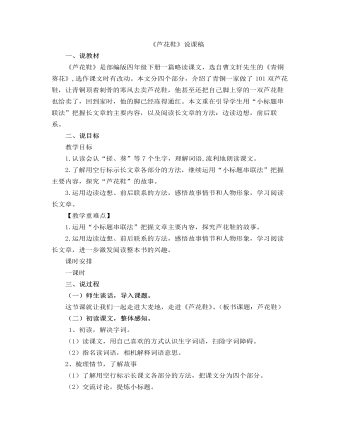
部编人教版四年级下册《芦花鞋》说课稿
一、说教材《芦花鞋》是部编版四年级下册一篇略读课文,选自曹文轩先生的《青铜葵花》,选作课文时有改动。本文分四个部分,介绍了青铜一家做了101双芦花鞋,让青铜顶着刺骨的寒风去卖芦花鞋,他甚至还把自己脚上穿的一双芦花鞋也给卖了,回到家时,他的脚已经冻得通红。本文重在引导学生用“小标题串联法”把握长文章的主要内容,以及阅读长文章的方法:边读边想,前后联系。二、说目标教学目标1.认读会认“搓、葵”等7个生字,理解词语,流利地朗读课文。2.了解用空行标示长文章各部分的方法,继续运用“小标题串联法”把握主要内容,探究“芦花鞋”的故事。3.运用边读边想、前后联系的方法,感悟故事情节和人物形象,学习阅读长文章。
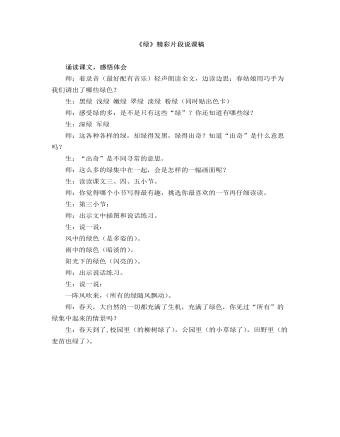
部编人教版四年级下册《绿》精彩片段说课稿
诵读课文,感悟体会师:着录音(最好配有音乐)轻声朗读全文,边读边思:春姑娘用巧手为我们调出了哪些绿色?生:黑绿 浅绿 嫩绿 翠绿 淡绿 粉绿(同时贴出色卡)师:感受绿的多:是不是只有这些“绿”?你还知道有哪些绿? 生:深绿 军绿 师:这各种各样的绿,却绿得发黑,绿得出奇?知道“出奇”是什么意思吗?生:“出奇”是不同寻常的意思。师:这么多的绿集中在一起,会是怎样的一幅画面呢?生:读读课文三、四、五小节。

人教版新目标初中英语八年级上册How do you make a banana milk shake教案2篇
1. First, ... then, ... next, ... finally, ...首先,……然后,……接着,……最后,……这是英语中表达做某事的步骤的一种说法。如果步骤较多,还可以说:first-next-after that-later on-finally/at last通常你会听到说英语国家的人在说 first, next, then, finally 和后面的内容时,他们会做一些停顿。这样就能提前告诉听者接下来讲的是一系列的步骤。这一点在朗读和听力中应特别注意。2. how many, how much均为疑问词,同是“多少”,但用法不同。请看:how many修饰可数名词复数,how much修饰不可数名词。但在用法上,同学们常犯如下错误:1) [误] How many are there bananas on the table?[正] How many bananas are there on the table?[析] how many, how much 中的many,much是形容词,常修饰名词作定语,故后面跟名词。2) [误]How much tea are there on the table?[正]How much tea is there on the table?[析] how much修饰不可数名词时,谓语动词用单数。how many与how much的区别可简记为:前how many:问“多少”,复数名词后面跑;how much问“多少”,不可数名词单数好。前者答语用基数词,后者答语用数量关系。

人教版新目标初中英语八年级上册What’s the best radio station教案2篇
教学重点和难点:运用所掌握的语言描述,比较不同地点的特点。在练习中学习掌握英语比较级和最高级的用法。课前准备分配小组,每组五至六人。通过上网或翻阅报刊杂志等方法,确定旅游线路,做出基本的旅游计划。教学设计:本节课流程图 学法指导:1.由于这是一堂新课,在教学中应注意面向全体,发挥学生的主体性,引导学生积极参与,激发学生的求知欲和学习积极性,指导学生积极思维,主动获取知识,养成良好的学习方法。逐步学会独立解决问题。总之要尽可能调动学生的非智力因素促进智力因素的发展。教法选择:1.电化教学法2.课堂讨论法3.任务型教学法采用这些方法的目的是为了充分调动学生的学习积极性,使学生变被动学习为主动学习。通过电脑形象的演示,加强印象,提高兴趣,突破难点,提高教学效率,进而增大教学的容量和信息量。充分体现教师为主导,学生为主体的教学原则。

人教版新目标初中英语八年级上册How was your school trip教案2篇
“Go for it!” is based on “Task-Based Language Teaching”. It adheres to “The authenticity principle”, “The form-function principle”, “The task dependency principle” and “The principle of learning by doing”. These principles all accord with the demands of curriculum focus.In and of Grade Seven (II), “Go for it!”, students have learned “The Simple Past Tense”. And it appears again in of Grade Eight (I). teaches students more about how to talk about events in the past. In addition, it gives affirmative and negative statements in the past tense, such as the sentence patterns “Did you see …?” “Were there …?” “Did you go …?” As the first part of Unit 8, Section A opens with a picture presenting the last school trip in the aquarium and continues with several step-by-step practice activities, which are all good for students to master “The Simple Past Tense”. Doing well in Section A will help students integrate the new target language with that in Section B. Thus, they can describe the events in the past freely and foster their own ability of reflecting and practicing. II. Teaching ObjectivesTeaching objective is the beginning and aim of teaching activities. According to the overall goal of the English elementary course--- improve students' synthetic ability of language application, which should be based on the development of students’ “Language knowledge”, “Language skills”, “Character building”, “Learning strategies” and “Cross-cultural awareness”. The teaching objectives are described as follows(I). Knowledge objectivesi. Master the simple past tense of regular and irregular verbsii. Recite the new words and expressions about the last school trip in the aquarium, including their pronunciation and intonation

人教版新目标初中英语八年级上册How do you get to school教案2篇
Step Ⅶ Role play ( Work on 1b)1. First ask two students to read the dialogue to the class.Sa: How do you get to school?Sb: Well, I ride my bike to the subway station. Then I take the subway.2. Now work with a partner.Suppose you use two kinds of transportation to get to school \Hangzhou\Beijing... (bus, train, subway, walking, bike, etc.) Tell how you get there. You may use the phrases in 1a.3. Then ask different pairs of students to present their conversations to the class.Step ⅧListening1. Work on 2a(1) First ask students to read the list of information that Thomas wants to know.…where Nina lives.…how far from school she lives.…how long it takes to get to school.…how she gets to school.…what she thinks of the transportation.(2) Tell students what transportation and bus stop mean.bus stop 汽车站 transportation n. 运送;运输Then tell students we'll hear a recording. Please put a checkmark in front of each thing that Thomas wants to know.(3) Now play the recording for students.( Have students pay attention to the sample answer.) (4) Then correct the answers.

人教版新目标初中英语八年级上册I’m more outgoing than my sister教案2篇
1 交通工具的比较此活动为小组活动。学生通过讨论找出到达某一城市可乘坐的各种交通工具,并选择最佳出行方式。Teacher:We’re going to Shanghai. How many ways can we use to get there? Yes, there are four ways: by bus, by plane, by train, by ship. Please discuss how you are going to get there.操作建议:(1)学生以小组为单位展开活动,谈论本组所选择的交通工具。(2)各组选代表向全班汇报,阐述本组所选择的交通工具的利和弊。完成任务所需要的语言结构:We can go there by ship. It’s more comfortable and cheaper than any other transportation.We can go there by bus. It’s cheaper but it takes longer time.2 哪个城市更合适?此活动具有挑战性。假设中国要举行2014年世界杯足球赛,分别从历史,人文,天气等方面对各城市(北京,大连,上海,昆明)进行比较,选择最佳举办城市。T: Imagine China is holding the 2014 FIFA World Cup. Which city do you think is the best for the World Cup, Beijing, Dalian, Shanghai or Kunming? Let’s work in groups. If you choose Beijing, please join the Team Red. If you chose Dalian, please join the Team White. If you choose Shanghai, please join the Team Blue. If you choose Kunming, please join the Team Green. Please show us its advantages. Then let’s see which team will win.

人教版新目标初中英语九年级上册Teenagers should be allowed to choose their own clothes教案2篇
Step 1 Greeting Greet the class and check the homeworkStep 2 A duty report The S on duty gives a report on the rules in his home and lead in 3a “Sun Fei’s and Wu Yu’s rules” Step 3 ReadingSs read the conversation and write the two girls’ rules in the chart. Check the answers.Get Ss to read after the tape and then read aloud by themselves. Then, T explains the language points.Step 4 Pairwork 3bRole play. Use the information in chart to practice with the conversation in 3a covered. They can look at the sample conversation in the right box.Step 5 Task 2 “Who’s the best reporter?”Make a survey by asking any 5 students the questions in the chart in activity 4. Then give out a report about it. See who is the best reporter? And the best reporter will get a nice ball-pen.Step 6 Summary and homework:Write out the report in your exercise-books.Period ThreeStep 1 Greeting and a duty reportThe S gives a duty report talking about his experience of being late for school. Lead in the question “Do you ever get to school late? How often do you get to school late? Always, usually, sometimes, or never?Step 2 1a Get Ss to finish writing.Step 3 Pairwork 1b Get Ss to talk about their answers with their partners using the sample conversation in the box on the right.Step 4 Listening practice2a Lead-in: What will happen if you get to school late? What about Peter? Let’s listen to a conversation between Peter and his father. Get Ss to finish 2a (As usual, for the first time, Ss only listen.) Check the answers.

人教版新目标初中英语九年级上册How do you study for a test教案2篇
内容提示本单元主要内容是学会利用verb十by/with gerund表示方式方法来讨论学习英语的策略,认识自己在学习方面的长处和不足。初步了解现在完成时的结构和用法。现在完成时由助动词have/has+动词的过去分词构成,主要表示过去发生的某一动作对现在仍有影响或造成的后果,常与already,yet,just,ever,never等副词连用。教学目标一、学习目标(Language Goal) 1. Talk about how to study . 学会讨论各种学习方法和策略。2. Find out your suitable learning methods. 找出适合自己的学习方法。 二、语言结构(Language Structures) 1. Verb + by with gerund by+动名词短语 表示“通过…途径,方法” 2. How questions have引导的特殊疑问句 三、目标语言(Target Language) 1. How do you study for tests ? 你是怎样准备考试的?Well , I study by working with my classmates. 哦,我和同学们一起学习。2. Have you ever studied with a group ? 你曾经参加过学习小组吗?Yes , I have . I’ve learned a lot that way . 是的,参加过。通过这种方式我学了许多。

人教版新目标初中英语八年级上册What are you doing for vacation教案2篇
Teaching goals : 1. Words & phrases: babysit ,get back , fishing , rent , think about , decide(on) , tourist etc. 2. How to talk about future plans . 3. 现在进行时表示将来计划或行动. 4. 特殊疑问句(where , when , how long引导) Important and difficult points : Drills :What are you doing for vacation ? I’m watching TV . When are you going ? I’m going … . How long are you staying ? We’re staying for five days . Teaching aids : cards and a tape ,a large wall calendar . Period 1 Teaching procedures : Step 1Leading in1. Free talk . 2. Put up the wall calendar . T: I’m staying home on Saturday (pointing to next Saturday ).Ss repeat . Ss: I’m staying home on Saturday . T: OK. Today we’ll learn how to talk about future plans. Step 2Pre-task SB Page 13 , 1a . 1. Look at the picture carefully and tell what you see in the picture . 2. Write the activities from the pictures in the box and add some more . 3. Practice reading . Step 3While-task1. Using the activities we write in 1a to make conversations .For example :What are you doing for vacation ? I’m visiting my uncle . 2. Pairwork .Practice in pairs . 3. 用第三人称练习对话.

人教版新目标初中英语八年级上册What’s the matter教案2篇
She shouldn’t go to the party tonight.Step7. TaskT: You know, there are lots of problems in our life. If you are a doctor, please tell us how to solve the problem. I will divide you into 9 groups. Please work in groups. And then choose one of you to report your ideas.The following are the problems:I have a toothache.I am hungry. I have a sore throat.I am stressed out. I have a sore back.I am tired. I can’t sleep.I have a cold. I have a headache.Report: If you have a headache, you should go to bed early. You should see the doctor. You should eat some medicine. You shouldn’t wash your face with cold water.You shouldn’t sleep late.You shouldn’t swim.…..T encourages the students to give advice as much as possible.Homework:1. Chose one of the problems, and write down your advice2. Copy the new words这一步是用于热身的,同时也可以让他们复习一部分的表示人体部位的单词,扩充知识.学习语言的过程也是一个不断积累的过程,复习旧知识,增添新知识.通过小游戏,强化学生对Does she/he have…这个句子的运用能力.通过复习,自然的引到下面新知识的学习。充分利用表格,由句子到对话,再到文章,让学生循序渐进. 提高学生的综合语言运用能力,运用以前学过的知识来解决身边的问题.Period 5 (Section B 3a—3c, selfcheck)教学内容与分析:

人教版新目标初中英语九年级上册Where would you like to visit教案2篇
The First PeriodⅠ.Teaching Aims and DemandsKnowledge Objects(1) Key Vocabularytiring, educational, fascinating, thrilling, peaceful, exotic, trek, jungle, take it easy, explore, historic, site(2) Target LanguageWhere would you like to go on vacation?I’d like to trek through the jungle, because I like exciting vacations.2. Ability Objects(1)Train students to talk about places they would like to visit with the target language.(2)Train students to describe vacations with different adjectives.(3)Train students' listening skill.3. Moral Object,It′s more interesting to go on vacating somewhere instead of staying at home.Ⅱ. Teaching Key Points1. Key Vocabularytiring, educational, fascinating, thrilling, peaceful, exotic, trek, jungle, take it easy, explore, historic, site2. Target LanguageTalk about different places with the target language.Ⅲ. Teaching Difficult Points1. Describe vacations with different adjectives.2. Talk about different places with the target language.Ⅳ. Teaching Methods1. Teaching by illumination2. Teaching by doing chain drills3. Teaching by pairworkⅤ. Teaching Aids1. A tape recorder2. Some pictures of different places with famous views
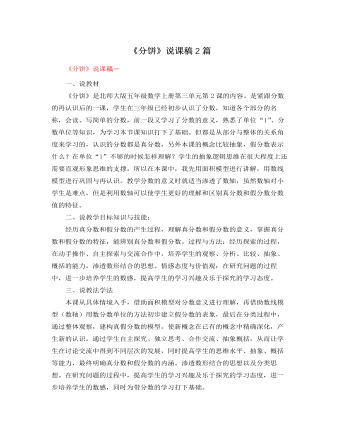
北师大版小学数学五年级上册《分饼》说课稿2篇
2、提出问题:3张大饼怎样能够平均分给唐僧师徒四人呢?每人得到大饼的多少张呢?3、揭示课题:分饼二、动手操作,探究新知:活动操作一:3张饼平均分给4个人。1、要求学生用准备好的圆纸片代表饼,剪一剪,拼一拼,画一画,小组交流自己的想法。教师巡视并进行指导。2、各小组汇报分法及分得的结果。(指名回答)第一种分法:把一张一张的饼平均分成4份,每人分每张饼的,共分一张饼的。并请学生上台演示分的整个过程。第二种分法:把3张饼叠起来,平均分成4份,每人分得3张饼的,也是张饼,请学生上台演示分的整个过程。3、演示学生两种分法的图片:4、请观察,这个分数有什么特点,分子比分母小,你还能举几个这样的例子吗?像这样的分数叫作真分数,真分数小于1。
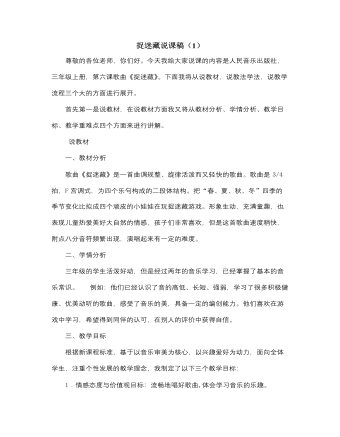
人音版小学音乐三年级上册捉迷藏说课稿(1)
第五个环节,完整教唱。在教唱过程中,首先采用师一句生一句的方式来学唱,接着利用黑板上歌词卡片的两种颜色,来进行师生接龙唱,例如第一遍,我唱蓝色的乐句,学生唱绿色的乐句,第二遍,则反过来。接龙唱以后则全部由学生自己,完整地演唱一遍。最后,我会让他们带着三拍子的强弱规律,再有感情地演唱歌曲。以上五个环节是我歌曲教学的部分。四、拓展部分(7分钟)这一部分我主要让孩子们分组对歌曲的后半部分进行歌词创编。例如,春天除了藏在花丛中,还可以藏在哪里?而四个小组刚好是春夏秋冬组,每个组探讨出一个词来进行创编。最后将新歌词改进去课件中,让孩子们自己来演唱自己创编的新歌曲。五、欣赏部分(5分钟)音乐中描写春夏秋冬四个季节的歌曲有很多,在音乐欣赏的部分,我会让孩子们通过点击课件中的四季娃娃,欣赏其代表的不同的四季音乐,最后进行简单的小结。
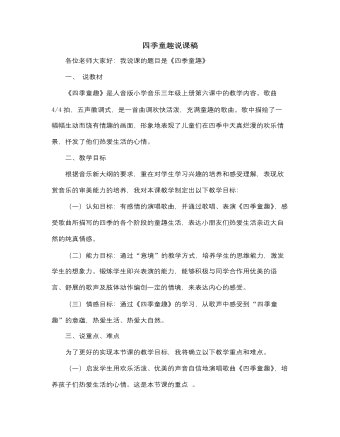
人音版小学音乐三年级上册四季童趣说课稿
同时,鼓励孩子采用其它方式表现歌曲意境。2、在充分地准备之后,各组成果展示。 最后通过学生互评和教师评价,发挥课堂的反馈作用,让学生体验到参与学习的乐趣3、教师小结:小朋友通过各自的方式表达了对四季美好景色的赞美,希望你们在今后的生活中去发现更多的大自然的美,拥抱美好的未来。[新课标指出,音乐教学应重视音乐与相关文化的适当渗透。在这个环节中,我设计了请学生自主发挥,选择多种艺术形式表现歌曲意境的方案,为孩子创造了一个可展现个性的舞台,还使学生感受到丰富多彩的艺术形式,激发学生的兴趣,拓展了学生的思维。六、课堂小结,组织下课 5分钟1、老师对本课内容做一小结:鼓励孩子们会善于发现大自然中的美,也希望孩子们都能成为一个善于表现美的孩子。对孩子进行思想教育。